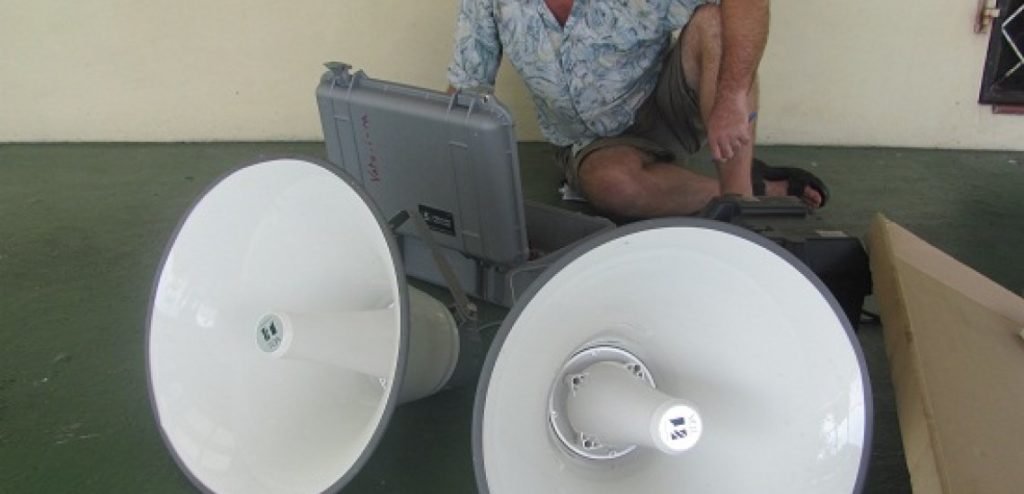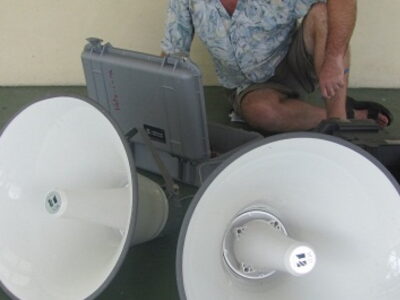Two staff from the BirdLife Fiji Programme and the Pacific Secretariat gave up any amorous intentions of their own on Valentine’s Day to try a little avian matchmaking.
Together with volunteers from the Vatu-i-ra Site Support Group (SSG), the team spent three days on Vatu-i-ra Island, Fiji, installing a solar-powered sound system designed to broadcast the calls of several threatened seabirds in a bid to attract them back to the island.
“We’re very excited to be contributing to the conservation of one of Fiji’s rarer species,” said Sione Gonewai of the Yavusa Nagilogilo, also Chair of the Vatu-i-ra Site Support Group.
“As the owners of Vatu-i-ra our community recognises our role as custodians of the site.
We’ve been working to protect the island, its seabirds and the marine environment upon which they depend for a number of years.”
In 2006 with the local community BirdLife undertook a successful eradication of Pacific rats, accidentally introduced by people many centuries before. Introduced mammals have been the number one driver of bird extinctions and their impact has been particularly severe in the Pacific.
However, thanks to a great deal of hard work across the BirdLife Pacific Partnership a number of islands around the region have now been cleared of invasives.
These sites are acting as safe havens for many species and Vatu-i-ra is no exception.

The island supports internationally significant populations of several noddies, terns and boobies; and already since the eradication survey teams have recorded encouraging signs of regeneration such as an apparent increase in the number of ground-nesting birds like Crested and Bridled Terns – those that are most susceptible to predation. Now the aim is to take full advantage of this site by establishing the first colony of Collared Petrels at a predator free location.
“Our mammal free islands are huge assets”, said Sialesi Rasalato, BirdLife’s Fiji Programme Conservation Officer. “Now we’re really looking to join all the dots and maximise the potential these sites have for conservation”. Petrels are the most threatened group of seabirds in the tropical Pacific having suffered historical declines owing to both overharvesting of adults and chicks for food and the negative impact of invasive mammals.
Collared Petrel was uplisted to Vulnerable on the IUCN Red List in 2011 because available evidence suggests its global population probably numbers fewer than 10,000 individuals and it is experiencing an ongoing decline.
Although surveys last year discovered that the species still occurs on a number of islands around Fiji, they also found invasive mammals present at all sites.
Remote playback has proven itself to be an enormously successful tool in New Zealand and elsewhere for attracting threatened seabirds to breed at specific sites. In this case, selecting a predator-free island offers the chance of establishing a colony of a very rare species where one of the major threats has been removed. The speaker system can run for up to five years, switching on every night to broadcast calls and turning itself off again to recharge in daylight.
As well as the sound system the team has installed 20 artificial nesting burrows to encourage the first birds in. “Collared Petrel is an obvious target, but we’re looking to benefit a number of Fiji’s rare and threatened seabirds like Tahiti Petrel and Polynesian Storm-petrel,” commented Sia Rasalato. 2012 marks the start of a real push for petrel conservation in Fiji.
NatureFiji-MareqetiViti are continuing their searches for petrel burrows with specially trained dogs on Gau, and have just installed a playback device to begin attracting birds to artificial burrows where they can be effectively monitored and protected. The BirdLife Fiji Programme and the Nabukelevu site support group on Kadavu are also beginning a similar project.
Donors
BirdLife would like to acknowledge all of its donors who have supported the important work described here: The David and Lucile Packard Foundation, the Aage V. Jensen Charity Foundation, the Pacific Seabird Group, the Crowder Messersmith Conservation Fund and Critical Ecosystem Partnership Fund.
Subscribe to The BirdLife Pacific Quarterly E-Newsletter


